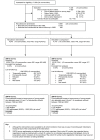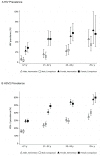Long-term biological and behavioural impact of an adolescent sexual health intervention in Tanzania: follow-up survey of the community-based MEMA kwa Vijana Trial
- PMID: 20543994
- PMCID: PMC2882431
- DOI: 10.1371/journal.pmed.1000287
Long-term biological and behavioural impact of an adolescent sexual health intervention in Tanzania: follow-up survey of the community-based MEMA kwa Vijana Trial
Abstract
Background: The ability of specific behaviour-change interventions to reduce HIV infection in young people remains questionable. Since January 1999, an adolescent sexual and reproductive health (SRH) intervention has been implemented in ten randomly chosen intervention communities in rural Tanzania, within a community randomised trial (see below; NCT00248469). The intervention consisted of teacher-led, peer-assisted in-school education, youth-friendly health services, community activities, and youth condom promotion and distribution. Process evaluation in 1999-2002 showed high intervention quality and coverage. A 2001/2 intervention impact evaluation showed no impact on the primary outcomes of HIV seroincidence and herpes simplex virus type 2 (HSV-2) seroprevalence but found substantial improvements in SRH knowledge, reported attitudes, and some reported sexual behaviours. It was postulated that the impact on "upstream" knowledge, attitude, and reported behaviour outcomes seen at the 3-year follow-up would, in the longer term, lead to a reduction in HIV and HSV-2 infection rates and other biological outcomes. A further impact evaluation survey in 2007/8 ( approximately 9 years post-intervention) tested this hypothesis.
Methods and findings: This is a cross-sectional survey (June 2007 through July 2008) of 13,814 young people aged 15-30 y who had attended trial schools during the first phase of the MEMA kwa Vijana intervention trial (1999-2002). Prevalences of the primary outcomes HIV and HSV-2 were 1.8% and 25.9% in males and 4.0% and 41.4% in females, respectively. The intervention did not significantly reduce risk of HIV (males adjusted prevalence ratio [aPR] 0.91, 95%CI 0.50-1.65; females aPR 1.07, 95%CI 0.68-1.67) or HSV-2 (males aPR 0.94, 95%CI 0.77-1.15; females aPR 0.96, 95%CI 0.87-1.06). The intervention was associated with a reduction in the proportion of males reporting more than four sexual partners in their lifetime (aPR 0.87, 95%CI 0.78-0.97) and an increase in reported condom use at last sex with a non-regular partner among females (aPR 1.34, 95%CI 1.07-1.69). There was a clear and consistent beneficial impact on knowledge, but no significant impact on reported attitudes to sexual risk, reported pregnancies, or other reported sexual behaviours. The study population was likely to have been, on average, at lower risk of HIV and other sexually transmitted infections compared to other rural populations, as only youth who had reached year five of primary school were eligible.
Conclusions: SRH knowledge can be improved and retained long-term, but this intervention had only a limited effect on reported behaviour and no significant effect on HIV/STI prevalence. Youth interventions integrated within intensive, community-wide risk reduction programmes may be more successful and should be evaluated.
Trial registration: ClinicalTrials.gov NCT00248469
Conflict of interest statement
The authors have declared that no competing interests exist.
Figures




Comment in
-
Where to for sexual health education for adolescents in sub-saharan Africa?PLoS Med. 2010 Jun 8;7(6):e1000288. doi: 10.1371/journal.pmed.1000288. PLoS Med. 2010. PMID: 20543993 Free PMC article.
References
-
- UNAIDS. Geneva: UNAIDS (UNAIDS/08.25E/JC1510E UNAIDS/08.25E/JC1510E); 2008. Report on the global HIV/AIDS epidemic 2008.362
-
- Temmerman M. Sexually transmitted diseases and reproductive health. Sex Transm Dis. 1994;21:S55–58. - PubMed
-
- Obasi AI, Balira R, Todd J, Ross DA, Changalucha J, et al. Prevalence of HIV and Chlamydia trachomatis infection in 15-19-year olds in rural Tanzania. Trop Med Int Health. 2001;6:517–525. - PubMed
-
- Pequegnat W, Stover E. Behavioral prevention is today's AIDS vaccine! AIDS. 2000;14(Suppl 2):S1–7. - PubMed
-
- UNICEF. New York: UNICEF; 2002. Young people and HIV/AIDS: Opportunity in crisis.
Publication types
MeSH terms
Associated data
Grants and funding
LinkOut - more resources
Full Text Sources
Medical
Miscellaneous

